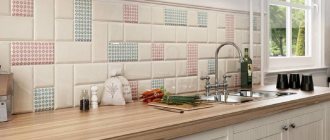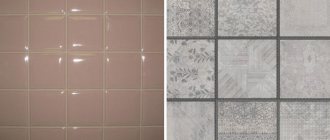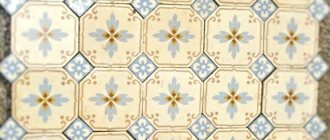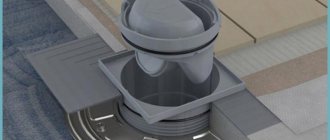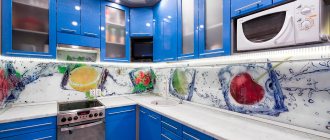Kitchen apron made of tiles: photos of practical solutions
The wall in the kitchen between the countertop and hanging cabinets is always visible and attracts attention. So it can be an interesting decoration for a room, unlike any other place, often giving the room a special style. In addition to aesthetic values, the properties of the material are also taken into account - the wall above the kitchen table is one of the places most susceptible to contamination, so it requires special finishing. Therefore, the area should be covered with a material that fits inside and is easy to clean. Ceramic tiles would be a good choice.
Ceramic tile is the material of choice for walls above kitchen counters. Not surprising, since it is non-flammable, easy to clean and resistant to water and steam. However, the popularity of tiles does not mean that walls decorated with them should look standard and boring. A wide range of ceramic tile manufacturers provides the buyer with a large selection and interesting solutions. To achieve an original effect, you can choose tiles that imitate wood, intense colors or unusual patterns.
Phototile
An apron in the kitchen can become a real art object if you cover it with photo tiles. Modern technologies make it possible to apply any original image to ceramic tiles, porcelain stoneware and even stone - be it a photo or a drawing. During the printing process, the tile heats up and special ink penetrates deep into the ceramic structure. As the manufacturers assure, it does not require special care, while the image remains durable and bright. Such panels look great on a light, plain background.
Spanish tiles Orion (Pamesa)
Advantages and disadvantages of tiles
The surface above the kitchen worktop must be particularly resistant to moisture, high temperatures, and stains, including greasy stains. Therefore, it is worth choosing tiles with a large layer of enamel, and if you choose other finishing options, do not forget to properly impregnate, clean and periodically maintain the material. The tiles should be chosen in accordance with the style in which the kitchen is decorated, taking into account the color of the countertops, furniture or flooring. Don't forget to plan how to finish the surface above the countertop, and also provide openings for electrical outlets.
Advantages of tiles:
- many interesting models, decor;
- wide range of prices;
- many of them are also very durable and allow you to protect the wall above the countertop for a long time;
- harmonious combinations with other finishing options;
- durability and resistance to high temperature and humidity;
- Easy to clean, maintaining a high level of hygiene in the kitchen.
Disadvantages of tiles:
- some of the models require impregnation and regular maintenance (especially stone);
- if present, tile joints should be treated and cleaned regularly;
- this is a long-term solution, so it is not suitable for those who like frequent changes in arrangement;
- installation takes quite a lot of time, knowledge and skills.
Tips for caring for tiles
To ensure that the tiles serve you for a long time and do not lose their original appearance, you should adhere to several rules:
Use special tile care products. Conventional detergents can damage the integrity of the tiles, scratch them or damage the paintwork. Tile care products are not much more expensive than ordinary household chemicals, but they significantly extend the service life of the surface coating.
The apron or wall should be washed after each cooking. To avoid difficulty cleaning the tiles later, wipe the tiles immediately after preparing a dish.
Use soft foam sponges or flannel fabrics. This way you will not damage or scratch the surface of the apron or wall.
Use a soft mop when cleaning tile floors. Floor tiles are not very different from those you use on walls, so it is also worth using softer materials when caring for your flooring.
When finishing the walls and floor of the kitchen, pay attention to the tile covering. Despite the high price, you get a beautiful, practical material that will last you a long time if you follow the rules of care.
Wall decoration with tiles is practiced in many rooms, including the kitchen, due to its practicality and design. Tiles can be selected to suit any decision; they have a lot of design options, which adds choice and gives free rein to your imagination.
Tiles for the kitchen: apron for work area - choice of options
The aesthetics of the wall above the kitchen countertop are important, but don't forget about practical considerations. Please note that this surface is particularly susceptible to dirt and splashes. This especially applies to parts of the walls near the sink and hob. Therefore, choose ceramic tiles that are easy to clean. It is best if their surface is smooth, covered with a thick layer of enamel. Then dust and other dirt will not settle on the surface so easily. Small wall tiles in the shape of a square or elongated rectangle serve well in the kitchen work area. In the case of small tiles, the surface of the joints is more susceptible to contamination. To make cleaning easier, you should choose larger tiles or straightened models that allow you to make really thin joints (1-1.5 mm). In the case of traditional, wider joints between tiles, it is worth using an epoxy compound, as it is practically waterproof and is resistant to chemical cleaners.
Apron design - basic recommendations
When choosing tiles for decorating a backsplash, you need to pay attention to a number of criteria.
- Tile type. Of course, there is not as much pressure on the backsplash as there is on the flooring. However, this area must be very resistant to heat and cleaning agents. The best option would be class PEI I and PEI II.
- Size. The edges of the apron should coincide with the furniture boundaries. The difficulty lies in the fact that the tiles are laid before the set is installed. If it is made according to standard dimensions, then you can focus on a tabletop with a height of 85 cm from the floor, while the standard height of the apron is 60 cm. Small square tiles (15*15) are considered the most convenient.
- Surface. It can be absolutely anything: glossy, matte, embossed. Each option has its pros and cons: Glossy cladding looks beautiful and creates a feeling of cleanliness with regular proper care. But you need to be prepared for the fact that any drop is visible on such a surface. On a matte surface, drops and splashes are not so noticeable, but over time, the porous surface becomes clogged with dust and drops of grease, and therefore requires more thorough cleaning. The embossed tiled surface looks very impressive, but is not practical as it gets dirty quickly.
- Color. To ensure that the apron is harmonious in the interior, it is better to choose a color similar to that of the furniture or tabletop. The apron can be a contrast to the set, but be combined with the color of the floor or wall decoration.
A bright, cheerful apron in a rustic-style kitchen,
no matter what option you choose when purchasing, it is important to consider that the tiles must correspond to the design idea of the room.
Kitchen backsplash tiles: patterns and fashionable colors
Wall tiles are an easy-to-install solution that offers a variety of installation options. It comes in different formats, colors and can be made from controversial materials. It is also a variety of design, size and decor. You can choose from a ton of varieties, allowing you to create effective finishes with a dash of ingenuity.
You can try modern and traditional cuisine in a retro, Provencal and even rustic style. See many interior design suggestions for kitchen tiles. You can beautifully decorate the space above the kitchen countertop using only this material. In a modern minimalist kitchen, a colored wall above the countertop will be an attractive element that will enliven the interior and give it an original character.
Fashionable kitchen tile designs are increasingly appearing not only on walls, but also on floors. However, patterned ceramics are a risky option. Fashion changes too quickly. Currently, the design of ceramic tiles is dominated by geometric motifs, but also in a 3D version. Textured kitchen tiles add life to a wall that can be very effective when lit correctly. It is interesting to combine smooth tiles with a relief pattern - clear, deeply cut lines are additionally highlighted with bright color, which gives the effect of an abstract pattern. Kitchen tiles can have oriental motifs, characterized by patterns with fuzzy lines.
Abstract watercolor prints on a canvas-like background are popular as it is another reference to art. This canvas-like motif on kitchen tiles is created by applying multiple layers of paint or a painter's palette, scratched out with a spatula after finishing work. All these tiles have one more thing in common. These are not only so-called decors, but also modules that can be freely composed and covered with large surfaces, forming magnificent decorations. Plain brick-style kitchen tiles are also trendy.
White tiles for kitchen backsplash
When choosing tiles, you should also pay attention to their color. White or cool tiles will give your kitchen a fresh and sterile character. This option goes well with both rustic and modern rooms. Metallic and natural concrete-imitating options, as well as those finished in natural tones, are ideal for minimalist and industrial kitchens. For ethnic or rustic interiors, choose white tiles paired with stylish decor in natural and warm colors. A tile with a bold color like red will stimulate your appetite and add a little spice.
Neutral colors
There's no doubt that more and more people are gravitating towards tiles in a versatile neutral color palette. They are usually soft grey, warm beige or ivory. It turns out, however, that even such boring colors can be diluted at first glance, since all you have to do is combine them with the appropriate structure. Wall tiles that resemble sandstone or other natural stone with an uneven surface deserve special attention.
Gray tiles will also become more expressive if they are decorated with a unique design, such as geometric or patchwork. This will allow the kitchen decoration to acquire a universal palette of colors, but with a touch of modernity.
Monochrome compositions
Monochrome compositions, for example, in the Scandinavian style, have enjoyed undiminished popularity for a long time. It's important to note that white, gray and black tiles not only look interesting, but they are also versatile. Thus, you can choose furniture of almost any color, obtaining an interesting effect. This will also allow you to reorganize the kitchen later without losing aesthetics, as you can easily combine new furniture and appliances with wall and floor coverings in monochrome colors.
Options for updating kitchen tiles yourself
After assessing the extent of damage to the tiles, we decide on the type of repair. There are several design options.
Updating tile joints
Wearing of seams is the most common reason for the loss of attractiveness of a tile covering.
Mold and fungi bacteria accumulate in contaminated spaces between the tiles, the presence of which is unacceptable in the room where food is prepared and eaten.
Start by removing dirt and disinfecting the surface. To do this, you will need a stiff brush, a fluffy rag, household chemicals in dry or liquid form and warm water.
It is recommended to first treat with a cleaning agent and a brush, then rinse thoroughly with water and wipe with a dry cloth. If necessary, use antifungal agents.
Reference . A popular way to remove fungus using a weak vinegar solution: dilute 9% vinegar with water and rub into the tile joints with a sponge, let dry, then rinse.
Similar actions are recommended for any update option.
After cleaning the seams, start updating. As a rule, it is carried out by whitewashing or painting the old joint covering. When the seam dries after processing, it is painted, removing excess paint from the surface with a soft damp cloth.
For deep seams, apply a fresh layer of grout. First, the old mastic is softened and removed with a construction scraper. After washing, treating with an antiseptic and drying, a grout mixture is prepared, which is used to fill the cleaned seams.
Replacement of cement grout and repair of damaged elements
In the case where the space between the tiles is filled with cement, an acid solution is applied to it before removal so as not to damage the tile. The seams freed from old cement grout must be vacuumed and cleaned with soapy water .
The next day, priming and application of fresh grout are carried out. You will need a tool to form the outside of the seam and a rubberized spatula to remove excess mixture.
If you wish, you can change the color of the grout and give the old tile a fresh look. The simplest option for such an update would be to use contrasting paint or a special marker.
It often happens that repairs are necessary not only to the seams, but also to areas of ceramic tiles that have become unusable. The appearance can be spoiled by cracks and chips that appear over time, which can be eliminated through cosmetic repairs.
Thus, a chip formed on ceramics can be masked with grout of the same color as the tile. Apply it in the required amount to the damaged area and smooth it out, removing excess. When the surface is dry, sand it with sandpaper to make it extra smooth and similar to the cladding.
Fractures on the tiles are formed due to the appearance of voids in the cement mortar. By gently tapping the entire surface of the tile with a rubber hammer, you will identify the elements that are moving away from the wall. A securely fixed tile will produce a dull, monolithic sound, while a problematic tile will respond with a ringing, hollow “voice.”
The easiest way to fix it is to add a solution underneath them using a syringe. If the seams around the cracked tile are intact and it is impossible to get to it with a syringe, then it needs to be replaced.
Ceramic tiles for kitchen backsplash
Ceramic tiles are one of the most popular and classic solutions. It is very durable, impressive and resistant to the harsh conditions that prevail in the kitchen. You will find mosaics of interesting combinations, as well as glass plates or those that imitate stone, concrete, wood or metal.
Ceramic tiles are the most classic way to decorate a kitchen countertop, and they are still very popular. By choosing this traditional cladding, you can get an unusual look for your kitchen splashback.
Not just ceramic tiles
In addition to ceramic tiles, tiles made from natural stone, a mass resembling natural concrete, brick or metal, are increasingly being chosen. The material gives a very original effect, and at the same time is quite practical. Metal tiles are a good alternative to sheet metal because they look more decorative and are easy to install. The result is suitable for both modern and industrial kitchens, combining beautiful looks with modern trends.
Products made from natural stone or its imitation go well with natural and ethnic interiors. You can get them in the form of slabs and panels, as well as interesting stone mosaics. Although marble slabs do not require much impregnation, models made of travertine or other porous materials must be thoroughly impregnated (preferably before grouting), because they are subject to destruction in kitchen conditions. However, despite this, they are willingly chosen for the apron because they look really impressive and fit many styles.
If you want your kitchen decoration to have an extraordinary appearance, then you should choose nice wooden or plastic panels, a very stylish, interesting design, texture and decor. But such material is quite demanding when it comes to impregnation, cleaning and maintenance. In addition, not everyone is suitable for the area above the stove. Plastic panels often have limited heat resistance, while wooden panels require durable impregnation.
Remember that cleaning wood paneling and tiles can be cumbersome, requiring careful sealing and frequent maintenance. However, despite the need for many maintenance procedures, the natural charm of wood is irreplaceable, which is why it is often used even on a kitchen apron. More and more people want to have wood paneling in their kitchen because it allows them to create a modern and idyllic mood.
Modern kitchen backsplash: different types of tiles
Tiles based on their manufactured material:
- ceramics (tiles, tiles);
- glass;
- clinker;
- wood or wood materials;
- metal;
- plastic;
- stone or its imitation.
Classification by installation method:
- Classic ones with slightly profiled edges - most often used, they require a fairly wide joint (depending on the size of the tile: usually from 2 to 10 mm).
- Straightened - allow almost seamless laying of tiles (grout even about 1 mm). They allow you to get an almost uniform panel that not only looks good, but is also easy to clean.
- Small mosaics that require precise targeting (usually about 1-2mm wide). Many of them are very effective, but remember to choose a durable seam and that they will require careful and frequent cleaning.
- With rounded edges for attractive combinations. Depending on the combination, they correspond to both rustic and ethnic styles.
Tiles according to shape:
- Square tiles are the most popular and come in a variety of sizes and colors and can be styled in interesting ways, including both classic and modern designs.
- Small mosaics are a very impressive option, although they are more often used for spacious kitchens because they can optically make them smaller.
- Rectangular tiles that resemble the edge of a brick. There are different colors: white, terracotta or with interesting colors and textures.
- Large format panels and tiles allow you to create an almost uniform, smooth surface and look good in spacious kitchens. They have different shapes and are readily chosen for modern and small rooms, which allows you to optically enlarge the interior.
Tile by style:
- ethnic;
- rustic;
- classical;
- modern (often with a touch of glamor);
- decorative, which can complement the classic version.
Shape and installation method
Parquet installation
Parquet laying involves laying out long narrow tiles in a herringbone or braid pattern (perpendicular to each other, with an upward angle). The interior looks quite unusual and interesting.
Since the aesthetic effect lies in the installation method, it is better to choose neutral, plain tiles (without patterns). But no one forbids you to combine several colors: the main thing is that the tiles are of the same series.
The inconvenience of installation is that the tiles along the edges of the room will definitely have to be cut. To simplify the task and save on materials, select square tiles to match and cut them diagonally.
Diagonal masonry
With diagonal laying, the tiles are placed diagonally. This method of laying floor tiles will visually expand the space. But on the walls the effect can be the opposite. An undoubted advantage is that due to the oblique lines the curvature of the walls is leveled. But you also can’t do without cutting the slabs.
Mosaic masonry
Mosaics can be laid out from small tiles, or you can purchase ready-made large tiles with a mosaic texture. Such tiles can be easily adjusted to the required size without compromising their appearance. It is advisable to combine mosaics with medium or large sized tiles.
Since everything vintage is in fashion now, a mosaic made from fragments or pieces of old Soviet tiles can be an original and stylish solution.
Imitation brickwork
Imitating brickwork or laying tiles “staggered” is a fairly popular option today. Smooth parallel lines will be either strictly horizontal or strictly vertical. Due to this, you can achieve different visual effects. And if you combine several colors, then even patterns.
Seam-to-seam installation
And of course, the standard “seam to seam” installation, which involves clear and even rows. If there are not many options for laying square tiles, then rectangular tiles can be oriented vertically (to visually raise the ceilings) or horizontally (to visually expand the kitchen).
Define your kitchen style
When considering which tiles to choose for your kitchen, you first need to decide on the overall style of the room. Interior design always starts with a general idea of the entire room, and only then selects individual elements that fit the overall design. The style of wall tiles can either emphasize the overall design of the kitchen or create significant dissonance. You will choose the color and shape of the wall tiles to suit your style concept. The wide range of finishes in stores includes tiles from white to black, from light to dark, in almost the full spectrum of colors.
It should be remembered that white tiles are ideal for Scandinavian-style kitchens, gray and imitation concrete are suitable for industrial-style rooms, and wooden models are suitable for eco-style. You can also choose decors that will give your interior a rustic or, for example, Moroccan character. Models with a smooth, uniform surface, designed in expressive colors, fit into a modern interior, while models in cream, beige or brown, additionally decorated with traditional ornaments, complement classic decor well.
It's worth considering whether you should choose tiles with a matte or satin finish? The first option looks good in a rustic and minimalist interior, it is easy to keep clean and does not leave stains on the surface. Satin tiles work well in modern and elegant kitchens, often making them look larger and adding a dash of glamorous style. However, the disadvantage is the need for regular cleaning and sometimes polishing of the surface, since a lot of dirt is very visible.
Tile seam: features of choice
Besides the tiles, the choice of grout is important. Remember that the more joints there are, the more difficult it will be to clean the surface. In addition, moisture, dirt and mold can accumulate in cavities. For the wall above the countertop, you should choose options that are durable, flexible, and resistant to calcium deposits and mold (epoxy is usually recommended). Dark grout lines are more practical because they don't show dirt, but they won't work on every tile. If you want to easily maintain a clean surface, consider choosing straightened tiles. They will provide a smooth, easy-to-clean surface (with joints of approximately 1mm).
What else should you pay attention to when choosing tiles?
In addition to the practical function, it is also worth paying attention to the aesthetic values of tile joints. They are available in many colors, and you can also choose decorative compounds (eg glitter). Pay attention to solutions that are similar in color to the tiles, but also contrasting. It is worth matching them to the entire arrangement, also taking into account the color of the tabletop, furniture and floor.
Stages of choosing tiles
Tile is a durable material, so replacing it is considered expensive. So, before you start choosing tiles, you must:
1. Create a kitchen design project, imagine what colors and furniture you will use, how to decorate it. If you have a set, you need to select a tile to match its color.
2. You should not buy tiles that are accurate to the piece. After installation is complete, you may still have packages of unnecessary tiles left. But you should not purchase material “meter by meter”. During the installation process, tiles sometimes break, break, and other force majeure events may occur. Experts advise stocking up on tiles within 10-15% of the total volume.
3. If you order material through an online store, you can see online. By taking advantage of the offer, you entrust the calculation to professionals. It happens when the calculations turn out to be incorrect and a lot of unspent material remains. Therefore, adjust the calculations yourself.
4. An important issue that needs to be discussed with the seller is the return of unused tiles back. Some stores refuse customers this service.
5. Before purchasing a material, you must carefully check it for cracks or defects in the store.
6. Carefully consider the size of the tiles. Because by cutting a tile to the required size, you can ruin it and the design will take on an awkward appearance.
7. When choosing a material, it is necessary to take into account its functionality. For the kitchen, tiles that can withstand grease and chemicals are suitable. Ceramic tiles have their own specific markings. For the kitchen, a good choice would be a marking with the letters AA.
Read: Glass kitchens: facades, apron, tables - 80 photos of the best kitchen design ideas
The choice of tiles for the kitchen should be made wisely, taking into account all the features of the room. On the website you can see photos of kitchen tiles.
Choosing the shape and size of tiles based on the parameters of the room: practical advice
If the color and texture of the tiles have already been selected, all that remains is to determine their size and shape. At this stage, it is worth remembering a few important tips that will also allow you to optically match the tiles to the room.
Large tiles should be avoided in small kitchens. The visual appearance of the wall above the kitchen countertop also depends on the grout, which creates perpendicular lines between the tiles. For large tiles, these lines may appear in random places and divide the room too clearly. In addition, there is also the risk of creating a large amount of waste after the necessary trimming of the tiles.
Smaller tiles are better for small kitchens. They can be square or rectangular models. This choice already depends on the overall style of the kitchen. To make the room a little bigger, you should choose shiny tiles or with mirror elements. Mosaic for the apron will also look good.
Large kitchens allow you to experiment. Large tiles will work great in these, giving you the effect of an almost uniform, smooth wall. With modern and minimalist decorations, they will completely serve their purpose. Using mosaics in large and open kitchens can give a glamorous effect. This type of kitchen finish will lose all its charm as it blends into a large space.
Expert advice! If your kitchen is small, it is best to choose wall tiles that are light in color and have a high sheen. Thanks to this, the room will look optically larger. It is also a good idea to use mirror elements that can reflect the opposite part of the kitchen - this is another way to create an optical illusion to make your interior seem larger than in reality.
Mosaic tiles for kitchen
People who are satisfied with a kitchen in a minimalist or Scandinavian style can make mosaic tiles in the kitchen. They bring energy, color and character to the interior. An interesting effect can be achieved not only with mosaics, but also with decor.
Shape and size of kitchen tiles
Shape and size are just as important as color and texture. When choosing wall tiles for your kitchen, there are a few important tips to follow that will allow you to customize the tiles in the room. Basic placement rules:
- In small kitchens, do not use large tiles, which will visually make the room smaller; in small rooms small or square tiles look best; to optically enlarge the room, you should use glass tiles or mirror tiles in the tile; mosaic is also suitable for a small kitchen;
- In large kitchens, you can use large tiles, which will give the wall the effect of complete smoothness; preferably primarily in modern interiors; mosaic is not recommended because it can create a strong glamor effect and the patterns will blend over a large space.
How to combine tiles with other kitchen elements?
In interior design, it is important to maintain harmony and uniformity of style. If you choose dark furniture, be sure to balance it with, for example, a light wall or floor color. Same thing with kitchen tiles. If the kitchen is dominated by dark, almost black furniture, you should choose a lighter shade of tiles for the walls and floors. Wall tiles can contrast with the color of the furniture or blend harmoniously with it. If you care about maintaining similar colors in the interior, you can diversify the wall cladding with decor, the design of which will add dynamics to the design.
It is also important to match the tiles to the overall style. If the kitchen is made in a vintage style, then small square tiles that imitate old tiled stoves will be a good choice. If you choose a trendy Scandinavian style, limit the colors in your kitchen to shades of white, black and brown.
Expert advice! Wall tiles can be fixed not only horizontally, but also vertically. An interesting effect is achieved by applying an appropriate shift or choosing tiles in the original hexagon shape. The joint you use for the backsplash will also be significant. This color analogue will be the least noticeable, which will have a good effect on the decor of a muted kitchen. Conversely, a contrasting grout will allow you to highlight the interesting tile arrangement, but be careful not to make the space appear smaller.
The texture and patterns on the tiles are also important. Tile with clear geometric patterns can be chosen for single-color kitchen facades. Wooden furniture combined with a clear tile texture that imitates concrete, for example, is not the best combination. This type of finish will be better in spacious loft-style kitchens.
How to lay tiles in the kitchen: a beautiful apron
In addition to the choice of tile model, the installation method also has a significant decorative effect. In addition to the usual lattice, you can also arrange the material:
- diagonally (diamonds);
- in a checkerboard pattern;
- use mixed placement.
The tiles located on the apron can consist of contrasting combinations, for example, white and black or dark blue, and can also be enriched with interesting decorative compositions. Place rectangular tiles to imitate natural brick. Tiles can be arranged in a modular manner, creating a harmonious arrangement that is a combination of tiles of different shapes, formats and installations. It should be remembered that the tile pattern can visually enlarge or reduce the interior.
Fashionable tiles for the kitchen - patterns, colors, textures
Tile trends change every season. In 2020, modernity and minimalism are the dominant trends. The most popular is white tiles for the kitchen, which are combined with dark matte and semi-matte furniture, as well as elements made of gold, dark blue and turquoise and shades of natural wood.
If we have a small kitchen that is open to other rooms, then it is worth choosing one type of tile throughout the entire interior. This procedure will significantly affect the optical expansion of the apartment.
Kitchen apron under tiles
Not everyone knows that wallpaper can also be successfully used over kitchen countertops. This allows you to quickly change the kitchen by creating a beautiful backsplash under the tiles, as well as getting a smooth surface decorated with an interesting color, pattern or print. Wallpaper for the kitchen is becoming more and more fashionable, and their selection allows you to create really interesting effects.
Important! It's best to choose specialty kitchen wallpaper designed for that room (usually vinyl with a non-woven backing or the more expensive fiberglass) because it's stain and heat resistant and can be easily cleaned.
You can choose wallpapers with interesting graphics, but also ones that mimic other materials, such as tiles. This option will allow you to get a rich color finish that best suits your interior and taste. Wallpaper with light tiles will give a pleasant, sterile effect, and those created in cool colors will bring a bit of Greek freshness or sea relaxation, warm colors will be cozy, and red ones will be able to stimulate the appetite.
Advantages of wallpaper in the kitchen:
- allow you to create interesting patterns, colors and textures;
- they are easy to clean;
- they are quite cheap and easy to glue;
- some can be painted;
- allow fairly frequent and simple changes in location;
- allow you to compensate for slight unevenness in the walls.
Disadvantages of wallpaper in the kitchen:
- protrusions on the wall require careful processing;
- incorrectly chosen wallpaper can quickly deteriorate and become discolored.
Unusual ideas for kitchen backsplash tiles
In modern interior design trends, you can see a slow shift away from traditional finishing materials such as ceramic tiles. An interesting alternative for them, among other things, are metal or wooden panels, which are placed on the wall between the kitchen countertop and the top line of cabinets, that is, in the apron area. Tempered glass wall cladding is also a great option because, despite its appearance, the material is durable and easy to clean. In the market, you will come across a wide range of glass kitchen tiles decorated with different motifs. Often you can even design the print design that will be on them yourself.
Modern design trends try to make the most of nature. That's why there are so many interesting things about panels for the backsplash area in the kitchen. However, if you do not trust such solutions and are afraid that the material will not work, then you can apply proven ceramic floor tiles decorated with imitation wood. Thus, you will get an apron that resembles a natural material with a characteristic grain, but is much more durable and easier to clean.
Compositions in the industrial loft style, in which raw brick reigns on the walls, enjoy unabated popularity. If this almost ascetic severity is not our style, and you want to add a little coziness, then you can lay brick tiles with an uneven texture, but with a warm tint. Wall tiles in sandy beige, light gray or even white would be ideal here.
Preparatory work
When planning to update ceramic tiles, first pay attention to the preparatory work. Remove dining furniture from the kitchen, remove wall cabinets, remove the stove and sink. If interior items do not interfere with repairs, cover them with polyethylene to protect them from damage and contamination.
If you do not want to use the services of professional builders, but decide to update the tiles in the kitchen with your own hands, take care of safety precautions. If necessary, use rubber gloves and safety glasses.
Hexagonal tiles - for the brave
Modern interiors love non-obvious solutions that diverge from what is known and traditional. It is therefore not surprising that kitchens designed in this way are moving away from standard, square or rectangular shaped wall and floor tiles. So you can get carried away by your imagination and choose tiles in an unusual shape. Hexagonal, that is, honeycomb tiles are currently very popular to create various compositions.
Expert advice! Hexagons fit perfectly into the Art Deco style, especially if they are in a shiny color such as pewter or gold.
Boar tiles for kitchen backsplash
An interesting effect can also be achieved by choosing classic shaped tiles. An excellent example of such cladding are rectangular models, that is, hog tiles. Even the simplest shape will attract attention if it is laid out in a non-standard pattern. Rectangular hog tiles placed on the wall in a decorative thin mosaic will look unusual. You can also use them as decoration and combine them with normal sized tiles.
Geometric abstraction
Geometric shapes have long reigned in kitchen compositions, including symmetrical rectangles, straight lines with decors and diamond-shaped patterns. To fit them into modern interiors, you must add a little color to them. In this option, the tiles will effectively contrast with the environment, as this will further emphasize its unusualness.
Kitchen wall tiles are one of the most common ways to finish the space between countertops and cabinets. The right choice of backsplash finish can affect the final effect of the entire interior design. Think carefully about your kitchen tile options when planning your room. There are many options, and a huge selection of backsplash designs will allow you to choose beautiful tiles to suit any idea.
